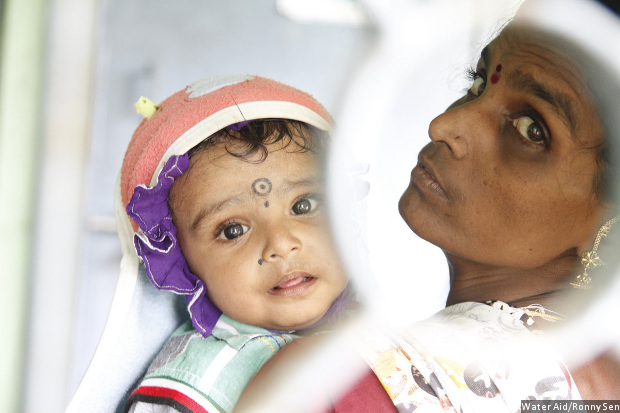Indian Children Healthier Than Ever, But Other Nations Doing Better: Latest Data
India’s infant mortality rate (IMR) reduced by 16 points over the last ten years--41 children below the age of one died per 1,000 live births, down from 57 a decade ago, according to the India fact-sheet of the National Family Health Survey 2015-16 (NFHS-4), the largest-ever assessment of India’s health and family welfare indicators.
The survey, released after a decade—the last survey was in 2005-06--reveals a 24-point reduction in India’s under-five mortality rate: From 74 children under five dying for every 1,000 live births in 2005-06, it is now 50--comparable to the poorer African island nation of Madagascar.
Source: National Family Health Survey, 2015-16
There has been similar improvement in almost all childhood health indicators, pointing to the fact that many Indian children are doing better than they ever have.
However, there is a long way to go: India’s IMR of 41 still lags other poorer neighbours, such as Bangladesh (31) and Nepal (29) and the African countries of Rwanda (31) and Botswana (35).
India’s under-five mortality (50) is substantially worse than its poorer neighbours, such as Nepal (36) and Bangladesh (38) and Bhutan (33).
Mortality Rates: A Comparison
| Indicator | India in 2005-06 | India in 2015-16 | Better than India | Worse Than India | On par with |
|---|---|---|---|---|---|
| Infant mortality rate | 57 | 41 | Bangladesh (31), Nepal (29), Rwanda (31) | Haiti (52), Senegal (42), Pakistan (66) | Ethiopia (41) |
| Under-five mortality rate | 74 | 50 | Nepal (36), Bangladesh (38), Bhutan (33) | Pakistan (81), Rwanda (45), Bostwana (44) | Madagascar (50) |
Source: National Family Health Survey, 2015-16
Although it has reduced infant deaths by 48% over 23 years, from 79 in 1992-93 to 41 in 2015-16, India is far from the 2015 millennium development goal--set in consultation with the United Nations--of an IMR of 27, IndiaSpend reported in January 2017.
There are large differences among states. For example, Chhattisgarh had the highest IMR (54), and Madhya Pradesh the highest under-five mortality (65) in the country, while Kerala’s IMR (6) and under-five mortality (7) rates were the lowest.
Mizoram was the only state to report an increase in infant mortality--from 34 deaths per 1,000 live births in 2005-06 to 40 in 2015-16. The data for Uttar Pradesh have not been released.
More children are getting immunised
As many as 62% of Indian children between the ages of 12 and 23 months were fully immunised—for BCG, measles, and three doses each for polio and diphtheria and tetanus--up from 43.5% in 2005-06.
Immunisation is known to be the most cost-effective method to prevent disease and death. Every year, India loses 500,000 children under the age of two due to diseases preventable by vaccination, according to this March 2015 Press Information Bureau report.
As many as 90.7% of children were immunised in public-health facilities, compared with 82% in 2005-06; children immunised in private facilities dropped from 10.5% in 2005-06 to 7.2%.
Source: National Family Health Survey, 2015-16; Children aged 12-23 months
More children with diarrhoea taken to a health facility
The proportion of children under the age of five who reported suffering from diarrhoea in the two weeks preceding the survey was nearly constant over the decade--9.2% in 2015-16 compared to 9% in 2005-06.
However, the proportion of children with diarrhoea who received the recommended treatment of oral rehydration salts (50.6%) doubled compared to a decade ago (26%).
More children with diarrhoea were taken to a health facility (67.9%) compared to 2005-06 (61.3%)--indicating increased awareness about common childhood diseases and recommended treatment among parents.
Source: National Family Health Survey, 2015-16; In the two weeks preceding the survey
Fewer stunted, more wasted children than decade ago
There was a 10 percentage-point decrease in stunted children--low height-for-age--below age five: From 48% in 2005-06 to 38.4% in 2015-16.
There was also a seven-percentage-point decrease in children under five who were underweight (low weight-for-age), from 42.5% in 2005-06 to 35.7% in 2015-16.
Fewer children between aged 59 months to six years suffered from anaemia in 2015-16, (58.4%) compared to 69.4% in 2015-16.
However, the proportion of children under five who were wasted--low weight-for-height--increased from 19.8% to 21%.
The number of severely wasted children increased from 6.4% to 7.5%.
Source: National Family Health Survey, 2015-16; *Children aged 6-59 months who had haemoglobin levels <11.0 g/dl
(Yadavar is principal correspondent with IndiaSpend.)
We welcome feedback. Please write to respond@indiaspend.org. We reserve the right to edit responses for language and grammar.
__________________________________________________________________
“Liked this story? Indiaspend.org is a non-profit, and we depend on readers like you to drive our public-interest journalism efforts. Donate Rs 500; Rs 1,000, Rs 2,000.”



